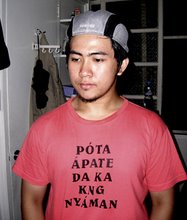Alben meng manyaman, boy!
November 9, 2008
The Rebellion of the Age 50+
The Rise of Teatru Ima at Arti
By Jason Paul Laxamana
Urban Kamaru
Central Luzon Daily
“Your Apung Monang used to be a zarzuela actress,” Ima would recount, referring to Simeona “Monang” Calma-Matsdairo, the sister of my maternal grandfather who got married with a Japanese man at the age of 14 during the Japanese occupation. Ima told me that in reaction to ArtiSta. Rita’s “Siwala the Musical” at St. Scholastica’s Academy which she and I watched together.
Apung Monang was young, active, and vibrant then. They would travel to different places within and outside Porac to perform various Kapampangan musicals, which most memorable to my Mom is a play called “Bunga Ning Dewakan.” She seemed to be so good and popular in her thespian career, in that one time two years ago, when Ima was buying some fruits and vegetables at the kabalenan of Angeles, a certain vendor whom we didn’t know asked her about Apung Monang; the vendor was actually a fan of hers.
Nakbag, Angat
Zarzuelas were halted for several reasons. Ima guessed that it could be because of the introduction of movies and, later on, television. Then, when the Mt. Pinatubo erupted, it seemed almost impossible to revive zarzuelas. Then came ArtiSta. Rita a decade after.
ArtiSta. Rita swept the “culturally ailing” and “theater-ignorant” province with their well-attended Kapampangan musicals and albums. It introduced several youths who showed what the Kapampangans can offer in the field of performance, and I personally cite Edward Bernabe, one of the lead male singers of the group, to be very promising.
ArtiSta. Rita is one of the groups that fuse career with the socialization of the talented Kapampangan youth on their ethnicity and heritage, including language. While everyone else is busy tapping young ones to participate in the industry of Kapampangan empowerment, Mr. Andy Alviz, Artistic Director of ArtiSta. Rita, found an often-ignored bracket of people and decided to tap their energy to play part in the emerging Kapampangan bandwagon—women with ages 50 and above, willing to develop and share their thespian skills to a seemingly ageist society. Altogether, the group came to be known as MaArti, or Teatru Ima at Arti.
Rebellion Against Ageism
Ageism is relatively a new concept in the Philippines. It is loosely defined as discrimination or marginalization based on one’s age, and the frequent victims of this are the youth (ageism against the youth or adultism) and the elders (ageism against the elders).
I first heard the term in Prof. Albina Peczon Fernandez’ Gender in Literature class when I was studying in UP Diliman, where we tackled the popular fate of female elders in modern Philippine society—they become stuck at home, become unpaid accomplishers of household chores and yayas to the grandchildren, and sometimes, even reprimanded—shouted at—for their fading memory power, right within the perimeters of the home they used to energetically build.
The performing arts, including theater and show business are breeding pools of ageism, the kind that would tend to discriminate the aged. Star searches on television want innocent teenagers the image of whom they can mold to their liking. The same goes for shows that search for the next local idol in singing. Theater, while less discriminating to the elderly compared to showbiz when it comes to performing, is still dominated by the young. And for female elders who are most probably stuck at home fulfilling the dictations of family tradition, they should be having lesser chances of being included in theater.
The members of MaArti are lucky, for their group is the first of its kind in the country, where elders take the limelight. It sure is a liberating experience for aged women to experience the spotlight in spite of the age (which a lot of women tend to conceal), the side effects of aging, the household responsibilities, and the ageist society.
As for a watcher like me, I actually find old people, especially old Kapampangan women, beautiful. And I don’t mean just physically beautiful, but beautiful in every sense of it. They seem to be very experienced, full of wisdom, and naturally funny. The Kapampangan woman is said to be a powerful member of the society, as well reflected in Brillante Mendoza’s films. In fact, in an interview with Mendoza for the film “Serbis,” he described Filipino society as “ruled by the women but it is the men who are in the forefront.”
Kebaitan Da Ring Ketuan
Rita Alarcon recounts how the group began. “Andy first brought up the idea two years ago but nothing came out of that plan. When the idea came out again in one of our conversations in the gym, he asked us if we were interested. When he saw the enthusiasm, he immediately told us to recruit people who may be interested in theater. Because of technology, we were able to gather a group of about 20 persons and by August 19 we had our first meeting.”
“We continued to recruit more through friends and had our first workshop after a week. The rest is history. Barely a month we had our script and after a month we had our launching and MaArti was born.”
Childhood or Current Dream?
It couldn’t have been a childhood dream of theirs to perform in front of people, but during their younger years, they had varying degrees of being inclined to performing.
“I do not recall if it was my dream to be a stage performer since childhood, but when I was in the States, I wanted to enroll and take up Theater Arts,” recalls Roxanne Gorospe. “Since I was a little girl, my elders would put me on top of the table and make me sing and dance. I come from a musically-oriented family and I guess that easily explains what I do now.”
As a student, Gorospe was often involved in events that required singing, dancing, acting, and choreography. She taught choirs of different age brackets at a young age and when college came, she took and finished a Bachelor’s Degree in Music Education, Major in Voice at the University of the Philippines College of Music. Behold: she also became a member of the prominent Philippine Madrigal Singers, and even became a vocal coach to Aiza Seguerra.
Her involvement in the Kapampangan industry is highlighted by her participation in the recording of Juan Crisostomo Soto’s “Alang Dios” along with Alviz himself.
For Dita Patawaran, on the other hand, she secretly wished to land on lead female roles in school dramas, but she often got in small roles. “In one of our school plays, the only role I was given was a bride with no single line to say,” recounts Patawaran. “I just had to walk down the aisle and that’s it.”
But who could have foretold that during their launching at ArtiSta. Rita’s “Pamanuli” Concert at the Holy Angel University, she would act the role of a supladang palengkera?
Alarcon actually never dreamt of taking performing as her chosen career path despite of being a regular participant in school plays. “But when the opportunity to have workshops with no less than Andy Alviz,” she said, “we grabbed the opportunity.”
Bayung Experience
In theater, youngbloods are often the ones sought for. But Alviz thought that the age group of MaArti members are “untapped resources.” Alviz expounds, “They are actually the most perfect artists in terms of experiences, maturity, confidence and depth.”
Asked about the difference between handling young thespians and the older, Alviz claims it’s basically the same. “No difference at all,” he declares. “These women can do anything. They are not old women, not aged; they are ripe, mature, and perfect for the harvest.”
Working most of the time with young actors age 40 and below, Alviz finds working with MaArti members a learning experience for him. “These women have so much passion discipline and love for what they are doing.”
True enough, as in spite of the side-products of aging, these women still find time and effort to attend their twice-a-week workshops with their director. Aging is “embellished” with various features my own mother would often make saingsing about—rheumatism, arthritis, depreciated stamina, blood pressure, memory gaps, etc.
Source of Strength
Surprisingly though, the idea of MaArti is claimed to be, as Alarcon would say, “a therapeutic source of physical and psychological strength.”
Patawaran testifies on this. “In one of our rehearsals,” she reports, “I heard someone say, Ba’t kaya patye Lunis at Webis, ala kung panamdamang másakit, lalu na istung miblas na ku para munta kening workshop tamo?”
“In a great big way, these women are very healthy, exciting, riotously ready to do anything Andy would tell them,” Gorospe asserts. “The things you mentioned (arthritis and all) are present in some but no worries. I myself am experiencing the challenges of being pre-menopausal.” She further humorously elaborates, “I have ovarian cysts, oneng sabi na pin Andy: Sus, nowadays if you don't have ovarian cysts, ali ka ‘in.’ I think by this time mengalaglag no reni king kaka-ayli!”
Corito Tayag of Angeles City shares a different story though. In spite of age, she claims to be a healthy woman. She does Tai Chi about four to five times a week and dances a lot, which she considers as exercise. A disclaimer though from her: “I guess the biggest problem would be the senior moments: the memory gap!”
In spite of everything, these women want to keep on doing what they’re doing as long as their health permits it, as long as there is clamor for the group, and as Gorospe puts it, as long as “e ya susuku i Andy kekami.”
And the Family Says…
MaArti members are most probably mothers and homemakers. How do their better halves and children react to their joining a theater group?
Gorospe, Alarcon, and Tayag can say in unison that their husbands and children have no apprehensions on their MaArti participation. “My husband is very supportive and proud that I can dance and perform on stage,” Tayag says. Alarcon narrates that her daughter and husband even came to watch her during the “Pamanuli” concert.
Patawaran has a different story to tell. “As of now, they frown at me,” she laments. “Maybe they could not imagine I can do it because I don’t even have the art of cooking. At times they even complain why I am nowadays always out of the office. I even jokingly said in one of our interviews that I was already fired so I have no choice but to take my early retirement.”
But when these women become fully and successfully transformed—after the CDs, commercial endorsements, radio and TV exposures, national, US and world tour that Alviz is envisioning for them the way he did for ArtiSta. Rita—will Patawaran’s family and other people skeptical of the potential of the group still frown? Patawaran tells us to “watch out and see.”
If Alviz and the group indeed materialize their plans—which I am praying for—then MaArti will go down in history and become a source of Kapampangan pride, and perhaps even Filipino pride, for the future generations to come, regardless of age.
Amanung susi:
Current Events,
Industry,
Issues,
Language,
Media,
Musings,
Personalities,
Practices,
Psychology
Subscribe to:
Post Comments (Atom)










2 comments:
Jason - pls post some Maarti songs on youtube!!
top [url=http://www.c-online-casino.co.uk/]casino online[/url] hinder the latest [url=http://www.realcazinoz.com/]free casino bonus[/url] manumitted no deposit perk at the chief [url=http://www.baywatchcasino.com/]bay take note of casino
[/url].
Post a Comment